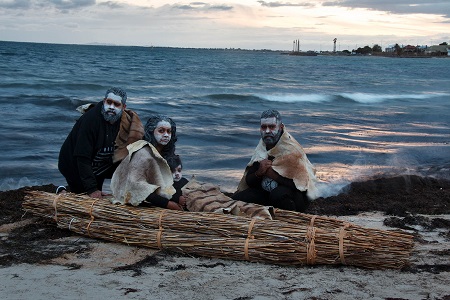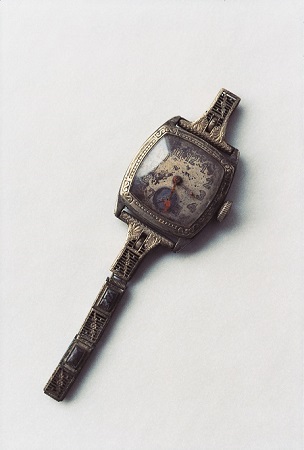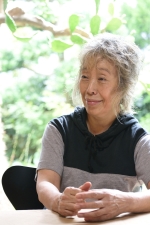
Polixeni Papapetrou, ‘The visitor’ from the series ‘Between Worlds,’ 2012. © Polixeni Papapetrou, courtesy of Michael Reid Gallery, Jarvis Dooney Galerie
The Tokyo Photographic Art Museum will adhere to relevant guidelines and take necessary measures to prevent the spread of the novel coronavirus. We ask for your understanding regarding inconveniences for this time. [Notices to Visitors]
Reversible Destiny
Australian and Japanese contemporary photography
Aug. 24—Oct. 31, 2021
- Aug. 24—Oct. 31, 2021
- Closed Monday (However, the museum will be open on the Mondays of August 30 and September 20,) September 21
- Admission:Adults ¥700 / College Students ¥560 / High School and Junior High School Students, Over 65 ¥350. *Admission is free for grade school children or younger; junior high school students living or attending schools in the Tokyo metropolitan area, holders of Japan’s disability identification cards (shogaisha techo) together with two caregiver, and holders of the museum’s annual passport.
It is recommended that you use the online ticket system (timed entry reservation.)![]()
click here for online ticket system: Webket
Co-curated by Natalie King
What does it mean to make photography now, in a time of global upheaval, human fragility and uncertain futures? “Reversible Destiny” is a group exhibition of Australian and Japanese photo-based artists who contemplate our destiny while reflecting on our shared past.
How is contemporary photography entangled with the past, halted in the present and imagining the future? Eight artists from Australia and Japan explore the uncanny ability of photography to collapse time and delve into the experience of the individual within a social context. In doing so, yesterday, today and tomorrow merge across an array of photographic renditions from epic landscapes to intimate interiors.
Australia and Japan have different cultural histories but today, when events far beyond our expectation are occurring every day, there are more and more experiences and issues that we can share across borders and time zones. Based on the theme of "Reversible Destiny," the exhibition will encourage audiences to understand the diversity of culture in both countries while enabling Australian artists to bring a global perspective and awareness to the international arena.
The double bind or paradox of “Reversible Destiny” alludes to cycles of the past and future; life and death; remembering and forgetting; hope and regret. Together, these mutual contradictions shape the tempo of our times as frail and tremulous by presenting an array of artworks from 2-dimensional photography, installation and moving image. By shifting registers, these artists take us to newly imagined places with visions of the future that have been formulated in the past. They negotiate time and place, moving backwards and forwards between past and future, memory and the unknown.
Participating Artists| Maree Clarke / Rosemary Laing / Polixeni Papapetrou / Val Wens / Ishiuchi Miyako / Katayama Mari / Hatakeyama Naoya / Yokomizo Shizuka
Maree Clarke|
Maree Clarke, ‘The long journey home 2,’ 2018. © Maree Clarke, courtesy of Vivien Anderson Gallery
Born in Swan Hill, Victoria Australia. Clarke is a Yorta Yorta, Mutti Mutti, BoonWurrung, Wemba Wemba woman from northwest Victoria in Australia. Clarke has been a practising artist living and working in Melbourne for the last three decades with her work focussed on regenerating cultural practices and awareness, identity and knowledge.
Rosemary Laing|
Rosemary Laing, ‘effort and rush #1,’ 2015. © Rosemary Laing, courtesy of Tolarno Galleries
Born in Brisbane, Queensland Australia. Laing’s creative practice is conceptually-driven and flawlessly rendered with her works capturing physical or choreographed interventions undertaken in situ, and in relation to cultural and historically resonant locations throughout Australia.
Val Wens|
Val Wens, ‘Kawah Ijen 4(Ijen Crater)’ from the series 'Banyuwangi', 2018. © Val Wens, courtesy of KRONENBERG MAIS WRIGHT
Born in 1974 in Jakarta, Indonesia and now lives and works in Sydney, Australia. Val Wens’ multidisciplinary practice is focussed on self-portraiture and spans photography, video and performance. He creates photographic narratives, poems and metaphors that engage both myth and reality, as well as the broader human struggle.
Polixeni Papapetrou|
Polixeni Papapetrou, ‘The visitor’ from the series ‘Between Worlds,’ 2012. © Polixeni Papapetrou, courtesy of Michael Reid Gallery, Jarvis Dooney Galerie
Born in Melbourne in 1960. Papapetrou explores the relationship between history, contemporary culture, identity and being by creating scenic backdrops, landscapes, costumes and masks that were brought together to evoke poetic, surreal and dreamlike worlds between childhood and adolescence.
Ishiuchi Miyako|
Ishiuchi Miyako, ‘ひろしま/hiroshima #88 donor: Okimoto, S.,’ 2010. © Ishiuchi Miyako, courtesy of The Third Gallery Aya
Born in Gunma, Japan, and raised in Kanagawa. Ishiuchi commenced the series ひろしま/hiroshima for which she took image records of belongings left behind by victims of the atomic bomb since 2007, and she visits Hiroshima every year to photograph the belongings.Exploring the intersection of social history and more personal individual histories, her works have been highly acclaimed in both Japan and abroad.
Katayama Mari|
Katayama Mari, ‘in the water #008,’ 2020. © Katayama Mari, courtesy of Akio Nagasawa Gallery
Born in 1987 in Saitama, Japan and raised in Gunma. Through photography, sculpture and textile works, Katayama provokes an alternative narrative around the body by depicting her own physicality in intimate settings and elaborate scenographies.
Hatakeyama Naoya|
Hatakeyama Naoya, ‘2016. 6. 25 Takata-cho Nagasuka’ from the series ‘Rikuzentakata,’ 2016. © Hatakeyama Naoya, courtesy of Taka Ishii Gallery
Born in Iwate Prefecture, Japan, in 1958. Hatakeyama is renowned for his epic, large-scale photographic works that revel in the heightened tension that exists today between human culture and nature.
Yokomizo Shizuka|
Yokomizo Shizuka, ‘That Day,’ 2020. © Yokomizo Shizuka, courtesy of Wako Works of Art
Born in Tokyo, Japan and currently residing in London. Shizuka explores the documentary and fictional aspect of photographic representation through a focus on the moment of exchange between photographer and subject.
Natalie King Profile|Co-curator
Natalie King is a leading Australian curator, writer and senior researcher engaged with artists and institutions across the Asia-Pacific region. Current projects include Curator of Yuki Kihara, Aotearoa New Zealand at the 59th Venice Biennale 2022 and Series Editor of Mini Monographs with Thames & Hudson. Through her unique curatorial approach, King has initiated collaborations, partnerships, research and award-winning publications. In 2017, King was Curator of ‘Tracey Moffatt: My Horizon,’ Australian Pavilion, the 57th Venice Art Biennale. She has curated exhibitions for the Singapore Art Museum; the National Museum of Art, Osaka; National Gallery of Indonesia, Jakarta; the Museum of Contemporary Art, Sydney; Kaohsiung Museum of Fine Arts, Taiwan, amongst others. King has realised projects in India, Indonesia, Japan, Korea, Singapore, Taiwan, Italy, Thailand, Bangladesh, New Zealand, New Caledonia and Vietnam. King is an Enterprise Professor of Visual Arts, Victorian College of the Arts, University of Melbourne. In 2020, King was awarded the Medal of the Order of Australia (OAM) for "service to the contemporary visual arts". She is President of AICA-Australia (International Association of Art Critics, Paris); a member of CIMAM (International Committee for Museums and Collections of Modern Art) and Metro Tunnel Arts Advisory Panel; and a mentor for Mentor Walks.
www.natalieking.com.au
Organized by the Tokyo Photographic Art Museum (operated by Tokyo Metropolitan Foundation for History and Culture), the Tokyo Shimbun
Special Collaboration with University of Melbourne Supported by the Australian Embassy, Tokyo, the Australia-Japan Foundation, YOSHINO GYPSUM ART FONDATION
With Cooperation of Tokyo University of the Arts
[Related Event]
International Online Symposium on Contemporary Photography
"What does photography mean now in a time of global uncertainty?"


Reversible Destiny Australian and Japanese contemporary photography, Tokyo Photographic Art Museum, co-curated by Natalie King , 2021 ©Kenji Takahashi
Artists in "Reversible Destiny" look at what it means to make photography now, in a time of global upheaval, human fragility and uncertain future - what are our shared destinies across nations and how can we work better together? These are the issues that will be discussed in the symposium with in-depth interviews with each artist, mini lectures and panel discussion.
Date 15, 16, 17, October 2021 17:00- (JST) / 18:00- (AEST) daily
Symposium will be recorded and uploaded. Please click YouTube channel
*All programs are English/Japanese subtitled and free.
Program 1 [48'26]
Date and time : 15, October 2021 17:00- (JST) / 7pm- (AEDT)
Speakers:
[Interview] Ishiuchi Miyako, Maree Clarke, Katayama Mari (Exhibiting artists) and Olympia Nelson (daughter of Polixeni Papapetrou)
Natalie King, OAM (Co-curator)
Program 2 [54'37]
Date and time: 16, October 2021 17:00- (JST) / 7pm- (AEDT)
Speakers:
[Interview] Val Wens, Yokomizo Shizuka, Hatakeyama Naoya and Rosemary Laing (Exhibiting artists)
Natalie King, OAM (Co-curator)
Program 3 [1'26'45]
Date and time: 17, October 2021 17:00- (JST) / 7pm- (AEDT)
Speakers:
[Mini lectures and Panel discussion] Kataoka Mami (Director of Mori Art Museum and Artistic Director, Aichi Triennial 2022), Natalie King, OAM (Co-curator)
Ishiuchi Miyako (b.1947)

©Maki Ishii, courtesy of The Third Gallery Aya
Born in Gunma, Japan, and raised in Kanagawa. Ishiuchi commenced the series ひろしま/hiroshima for which she took image records of belongings left behind by victims of the atomic bomb since 2007, and she visits Hiroshima every year to photograph these items. Exploring the intersection of social history and more personal individual histories, her works have been highly acclaimed in both Japan and internationally.
Maree Clarke (b.1961)

©Eugene Hyland
Born in Swan Hill, Victoria, Australia. Clarke is a Yorta Yorta, Mutti Mutti, BoonWurrung, Wemba Wemba woman from northwest Victoria in Australia. Clarke has been a practising artist living and working in Melbourne for the last three decades with her work focussed on regenerating cultural practices and awareness, identity and knowledge.
Katayama Mari (b.1987)

©Mari Katayama, courtesy of Akio Nagasawa Gallery
Born in Saitama, Japan, and raised in Ota, Gunma. Through photography, sculpture and textile works, Katayama provokes an alternative narrative around the body by depicting her own physicality in intimate settings and elaborate scenographies. Katayama’s practice is shaped by her direct experience of her condition and society’s obsession and anxieties about bodily appearance.
Olympia Nelson

©Eugene Hyland
The daughter of the exhibiting artist Polixeni Papapetrou, Olympia Nelson has appeared as the main subject of Papapetrou’s works and part of her mother's creative process. Her mother, Polixeni Papapetrou(1960-2018)was born in Melbourne in 1960. Papapetrou explores the relationship between history, contemporary culture, identity and being by creating scenic backdrops, landscapes, costumes and masks that were brought together to evoke poetic, surreal and dreamlike worlds between childhood and adolescence.
Val Wens (b.1974)

©Val Wens
Born in Jakarta, Indonesia. Wens now lives and works in Sydney, Australia. Val Wens’ multidisciplinary practice is focussed on self-portraiture and spans photography, video and performance. He creates photographic narratives, poems and metaphors that engage both myth and reality, as well as the broader human struggle.
Yokomizo Shizuka (b.1966)

©Shizuka Yokomizo, courtesy of WAKO WORKS OF ART
Born in Tokyo, Japan and currently living in London. Yokomizo explores the documentary and fictional aspect of photographic representation through a focus on the moment of exchange between photographer and subject. In addition to works that are rooted in a cultural anthropological perspective, and based on the history of humankind creating images while acknowledging otherness, Yokomizo has developed work that centers on her own individual experiences.
Hatakeyama Naoya (b.1958)

Born in Rikuzentakata, Iwate, Japan. Hatakeyama is renowned for his epic, large-scale photographic works that revel in the heightened tension that exists today between human culture and nature. Since the Great East Japan Earthquake, he has been photographing the landscape of his hometown, Rikuzentakata, and written about the disaster, as well as about photography and art.
Rosemary Laing (b.1959)

© Cecilia Boote
Born in Brisbane, Queensland Australia. Laing’s creative practice is conceptually-driven and flawlessly rendered with her works capturing physical or choreographed interventions undertaken in situ, and in relation to cultural and historically resonant locations throughout Australia.
Kataoka Mami

© Ito Akinori Mami Kataoka
joined the Mori Art Museum in 2003, taking on the role of director in 2020. In her time at the museum she has curated a number of major solo exhibitions of work by Asian artists, among them Ai Weiwei (in 2009; 2012–14 for international touring), Makoto Aida (2012) and Chiharu Shiota (in 2019; 2019-2022 for international touring); other recent projects include a group exhibition Another Energy focusing on 16 women artists in their 70s or older (2021). Beyond Tokyo, Kataoka has held positions at the Hayward Gallery in London, where from 2007–09 she was the institution’s first international curator; she has also acted as co-artistic director for the 9th Gwangju Biennale (2012), artistic director for the 21st Biennale of Sydney (2018) and is currently artistic director for the Aichi Triennale 2022. Kataoka has been serving as a Board Member of CIMAM [International Committee for Museums and Collections of Modern Art] (2014-) and currently the President of CIMAM.
Natalie King

©Alli Oughtred
Natalie King is a leading Australian curator, writer and senior researcher engaged with artists and institutions across the Asia-Pacific region. Current projects include Curator of Yuki Kihara, Aotearoa New Zealand at the 59th Venice Biennale 2022 and Series Editor of Mini Monographs with Thames & Hudson.
Through her unique curatorial approach, King has a depth of experience across creative collaborations, partnerships, research and award-winning publications. In 2017, King was Curator of Tracey Moffatt: My Horizon, Australian Pavilion, the 57th Venice Art Biennale. She has curated exhibitions for the Singapore Art Museum; the National Museum of Art, Osaka; National Gallery of Indonesia, Jakarta; the Museum of Contemporary Art, Sydney; Kaohsiung Museum of Fine Arts, Taiwan, amongst others. King has realised projects in India, Indonesia, Japan, Korea, Singapore, Taiwan, Italy, Thailand, Bangladesh, New Zealand, New Caledonia and Vietnam.
King is an Enterprise Professor of Visual Arts, Victorian College of the Arts, University of Melbourne. In 2020, King was awarded the Medal of the Order of Australia (OAM) for "service to the contemporary visual arts". She is President of AICA-Australia (International Association of Art Critics, Paris); a member of CIMAM (International Committee for Museums and Collections of Modern Art) and Metro Tunnel Arts Advisory Panel; and a mentor for Mentor Walks. In 2021, she was awarded a University of Melbourne Excellence Award: The Patricia Grimshaw Award for Mentor Excellence.

